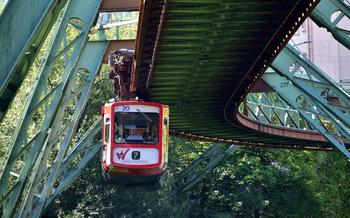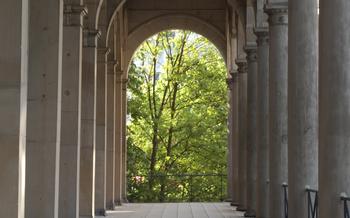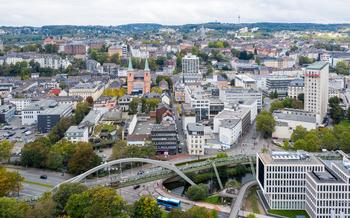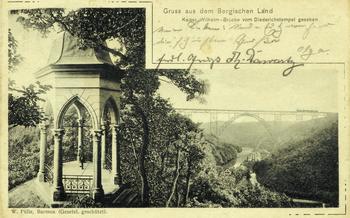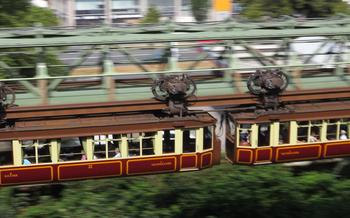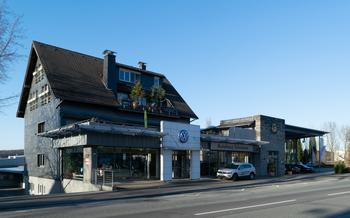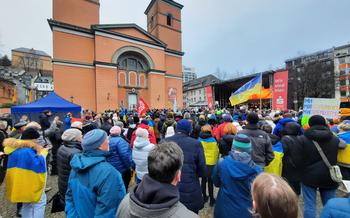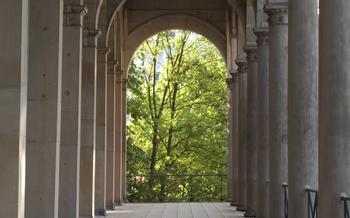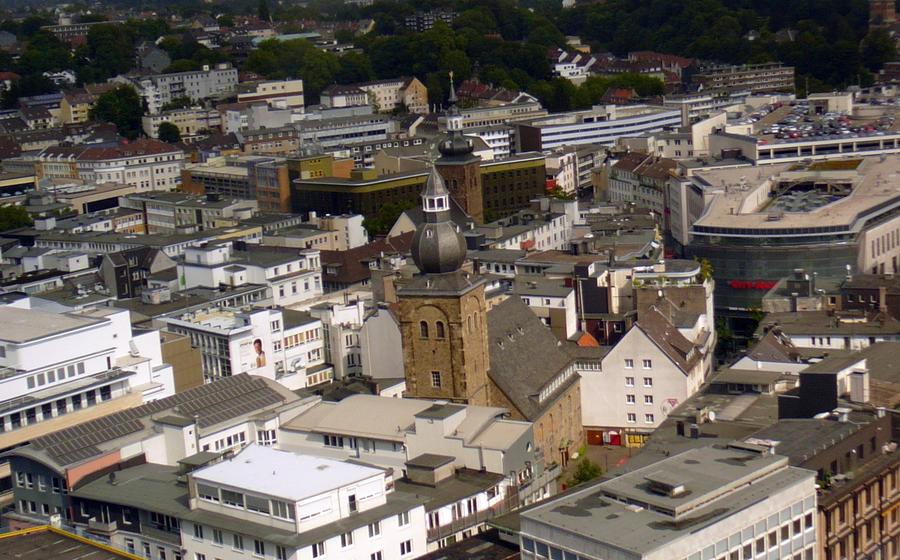
Wuppertal Suspension Railway Museum
- Historical Significance
- Technical Marvel
- Scenic Views
- Cultural Importance
- Practical Information
- Behind-the-Scenes Tour
- Suspension Railway Museum
- Engineering Masterpiece
- Sustainable Transportation
- Urban Planning
- Local Legends and Folklore
- Photography and Art
- Community Engagement
- Future Plans and Developments
- Insider Tip: A Hidden Perspective
Historical Significance
The Wuppertal Suspension Railway holds a pivotal place in the history of transportation engineering. Inaugurated in 1901, it stands as the world's oldest electrically powered suspension railway and the only one still in operation. The brainchild of Eugen Langen, a German engineer, and entrepreneur, the railway was born out of necessity. Wuppertal, nestled in the scenic Wupper Valley, presented unique challenges for transportation due to its steep slopes and narrow streets. Langen's vision was to create a mode of transport that could navigate these obstacles while providing a safe and efficient means of travel.
The construction of the suspension railway was a remarkable feat of engineering. Langen's team had to overcome numerous challenges, including designing a system that could withstand strong winds and vibrations, developing a reliable propulsion mechanism, and ensuring the safety of passengers. The innovative solution they devised involved suspended carriages running on a single rail, supported by a series of towers and cables. This design allowed the railway to traverse the rugged terrain without requiring extensive land acquisition or disrupting the existing urban fabric.
The Wuppertal Suspension Railway revolutionized transportation in the city. It connected previously inaccessible areas, facilitated economic growth, and became an integral part of the urban landscape. Its unique appearance and elevated vantage point quickly turned it into a city landmark and a symbol of German engineering prowess. Today, the suspension railway continues to operate as a vital part of Wuppertal's public transportation system, carrying millions of passengers annually and serving as a testament to the ingenuity and vision of its creators.
Technical Marvel
The Wuppertal Suspension Railway is a marvel of engineering, showcasing intricate technical details that have stood the test of time. Its carriages, suspended from a single track high above the Wupper River, are marvels of design and innovation. Each carriage is equipped with a pair of wheels that run along the track, providing stability and smooth movement. The supporting structure, consisting of slender steel towers and cables, is a testament to the precision and strength of German engineering.
The railway operates on the principles of gravity and counterweights, creating a unique and energy-efficient system. The carriages descend and ascend the slopes of the valley using gravity, while counterweights balance the load and ensure smooth operation. This ingenious mechanism allows the railway to navigate the undulating terrain of Wuppertal without the need for additional propulsion systems.
Safety is paramount in the operation of the suspension railway. The system incorporates multiple redundant support cables, ensuring that the carriages remain securely suspended even in the event of a cable failure. Emergency brakes and sophisticated control systems further enhance the safety of the railway, providing peace of mind to passengers and operators alike.
Ongoing maintenance and modernization efforts ensure the continued safe operation of the railway. Regular inspections, repairs, and upgrades are carried out to maintain the integrity of the structure and its components. The use of modern technology and materials contributes to the railway's reliability and efficiency, ensuring that it remains a vital part of Wuppertal's transportation network for generations to come.
Scenic Views
The Wuppertal Suspension Railway offers passengers a unique and breathtaking perspective of the city and its surroundings. From the elevated vantage point of the carriages, riders can enjoy panoramic vistas of the Wupper Valley, the lush green hills, and the cityscape below. The ever-changing scenery provides a visual feast throughout the journey.
As the railway glides along its elevated tracks, passengers can admire the verdant forests, tranquil meadows, and charming neighborhoods that line the Wupper River. The river itself, a shimmering ribbon of blue, meanders through the valley, creating a picturesque landscape. The railway also passes over several bridges, offering stunning views of the city's architecture and the bustling streets below.
The changing seasons bring their own unique charm to the views from the suspension railway. In the spring, the valley comes alive with vibrant colors as flowers bloom and trees sprout new leaves. In the summer, the lush greenery creates a verdant tapestry that stretches as far as the eye can see. Autumn transforms the landscape into a canvas of golden hues, with the leaves of the trees turning into a fiery spectacle. Winter brings a serene beauty, with snow-capped roofs and glistening icicles adorning the buildings and trees.
Many passengers choose to ride the suspension railway at different times of the day to experience the changing light and atmosphere. Sunsets are particularly magical, as the sky erupts in a kaleidoscope of colors that reflect off the river and the city skyline. Night rides offer a different kind of charm, with the twinkling lights of the city creating a mesmerizing sight against the backdrop of the dark sky.
Cultural Importance
The Wuppertal Suspension Railway holds a profound cultural significance, transcending its role as a mere mode of transportation. It has become an iconic symbol of German engineering prowess and innovation, a source of pride for the city's residents and a magnet for visitors worldwide. The railway's unique design and its seamless integration into the urban landscape have earned it recognition as a cultural landmark.
Local artists and cultural events often draw inspiration from the suspension railway, celebrating its rich history and enduring presence in the city's identity. Artists have captured the railway's essence through paintings, sculptures, and photography, while filmmakers have used it as a backdrop for their stories. The railway's distinctive silhouette and the breathtaking views it offers have made it a popular subject for creative expression.
Practical Information
To fully enjoy your experience with the Wuppertal Suspension Railway, it is essential to have some practical information at hand. Ticket prices vary depending on the distance traveled, but a single ticket typically costs around €Operating hours are generally from 6:00 AM to 11:00 PM on weekdays and 9:00 AM to 11:00 PM on weekends and holidays. The railway is accessible for wheelchair users and strollers, with designated spaces on the carriages.
To purchase tickets, you can either use ticket machines at the stations or buy them directly from the driver on the train. The system is well-integrated with other modes of transportation, and you can easily connect to buses and trams at various stops along the route.
For the best views, it is recommended to ride the railway during the day, especially on a clear day. However, the night rides offer a different perspective, with the city lights illuminating the valley below. To avoid crowds, try to travel during off-peak hours, such as early mornings or late evenings.
Once you are in Wuppertal, there are numerous attractions that you can combine with your suspension railway experience. The nearby Wuppertal Zoo is home to a diverse collection of animals from around the world. The Historische Stadthalle Wuppertal is a stunning concert hall known for its unique architecture and acoustics. And for a taste of local history, visit the Engels-Haus, the birthplace of the renowned philosopher and economist Friedrich Engels.
Behind-the-Scenes Tour
Beyond the regular passenger experience, the Wuppertal Suspension Railway offers a unique opportunity for visitors to delve deeper into its fascinating world through exclusive behind-the-scenes tours. These tours provide an insider's perspective on the railway's operation, history, and engineering marvels.
Participants gain access to restricted areas, including the maintenance depot, where they can witness the intricate process of servicing and repairing the railway's carriages. They also visit the control center, the nerve center of the system, where operators monitor the railway's operations and ensure its smooth functioning.
During the tour, visitors learn about the railway's history, from its early conception to its present-day operation. They gain insights into the challenges faced by the engineers and builders who brought this remarkable feat of engineering to life.
Visitors who have participated in the behind-the-scenes tour often come away with a newfound appreciation for the complexity and ingenuity of the Wuppertal Suspension Railway. They leave with a deeper understanding of its significance as a symbol of German engineering prowess and a cherished landmark of the city.
Suspension Railway Museum
The Wuppertal Suspension Railway Museum is a haven for history buffs and engineering enthusiasts who seek to delve deeper into the rich heritage of this iconic transportation system. Housed in a former railway station, the museum is a treasure trove of artifacts, documents, and exhibits that chronicle the suspension railway's journey from its humble beginnings to its present-day status as a global engineering marvel.
Visitors can embark on a captivating journey through time as they explore the museum's diverse collection. Vintage carriages, scale models, and interactive displays bring the history of the suspension railway to life, showcasing its technical innovations and the challenges faced by its builders.
The museum also sheds light on the cultural significance of the railway, highlighting its role in shaping the identity of Wuppertal and inspiring generations of engineers and innovators. Through the stories of the people who built, operated, and rode the suspension railway, visitors gain a deeper appreciation for its enduring legacy.
Guided tours led by passionate volunteers offer visitors an immersive experience, providing insights into the museum's collection and the fascinating tales behind the suspension railway. Whether you're a lifelong resident of Wuppertal or a first-time visitor, the Wuppertal Suspension Railway Museum promises an enriching and educational journey into the heart of this engineering masterpiece.
Engineering Masterpiece
The Wuppertal Suspension Railway stands as a testament to human ingenuity and engineering prowess. Its design and construction involved intricate calculations, rigorous structural analysis, and innovative techniques that were groundbreaking at the time. Engineers meticulously designed the railway's lightweight carriages and supporting structure to withstand the forces of gravity, wind, and vibration. The use of high-strength steel and advanced construction methods allowed for the creation of a remarkably slender and elegant structure that blends seamlessly with the surrounding urban landscape.
The construction of the railway presented numerous challenges, including the need to build over existing roads and buildings without disrupting daily life. Engineers employed innovative techniques such as cantilevered construction and prefabrication to minimize disruption and ensure the safety of workers and the public. The result is a remarkable feat of engineering that showcases the harmonious integration of infrastructure and urban planning.
The Wuppertal Suspension Railway remains a marvel of engineering, a testament to the vision and skill of its creators. Its unique design, innovative solutions, and enduring legacy continue to inspire engineers and architects worldwide, demonstrating the power of human ingenuity to shape and improve our built environment.
Sustainable Transportation
The Wuppertal Suspension Railway stands as a shining example of sustainable transportation, demonstrating how innovation and engineering can harmoniously coexist with environmental responsibility. Its operation relies primarily on electricity, a clean and renewable energy source, emitting no harmful emissions that contribute to air pollution. This eco-friendly mode of transport significantly reduces the carbon footprint associated with urban transportation, aligning perfectly with the global movement towards sustainable development.
The railway's elevated design not only offers breathtaking views but also plays a crucial role in reducing traffic congestion on the city's streets. By providing an efficient and reliable alternative to road-based transportation, the suspension railway helps alleviate traffic jams, improves air quality, and promotes a healthier urban environment.
The railway's success in sustainable transportation has garnered international recognition, inspiring other cities to adopt similar solutions. Several cities worldwide have expressed interest in implementing suspension railway systems, recognizing their potential to transform urban transportation and create more livable and sustainable cities.
In conclusion, the Wuppertal Suspension Railway serves as a testament to the power of innovation in driving sustainable urban development. Its commitment to environmental responsibility and its ability to reduce traffic congestion make it a model for future transportation systems, demonstrating how cities can embrace progress while preserving the delicate balance with the environment.
Urban Planning
The Wuppertal Suspension Railway played a pivotal role in shaping the urban planning and development of the city. Its unique elevated structure influenced the layout of streets, buildings, and public spaces, creating a distinctive urban landscape. The railway's construction presented both challenges and opportunities for city planners. They had to carefully consider the impact of the railway on existing infrastructure, property lines, and traffic flow.
The railway's elevated tracks allowed for the efficient use of space, enabling the construction of buildings and parks beneath the railway. This innovative approach to urban planning created a harmonious blend of transportation and green spaces, contributing to the city's overall livability. The suspension railway also facilitated the development of new neighborhoods and commercial districts, connecting them to the city center in a sustainable and efficient manner.
Local Legends and Folklore
The Wuppertal Suspension Railway has woven itself into the fabric of local folklore, inspiring tales and legends that have been passed down through generations. One popular legend tells of a mysterious figure known as the "Guardian of the Railway," a benevolent spirit who watches over the safety and well-being of passengers. According to legend, the guardian appears in times of need, ensuring that the railway operates smoothly and averting any potential disasters.
Another tale speaks of a love story that unfolded on the railway. A young couple, separated by fate, found solace in their daily commute on the suspension railway. As they gazed into each other's eyes from their respective carriages, they exchanged secret messages and dreams of a future together. The railway became a symbol of their enduring love, a place where their hearts could meet despite the obstacles that kept them apart.
These legends reflect the deep connection between the people of Wuppertal and their beloved suspension railway. They embody the railway's cultural significance as a symbol of hope, resilience, and the enduring power of human connection. Local storytellers often share these tales during events and festivals, ensuring that the railway's rich folklore continues to live on in the hearts and minds of Wuppertal's residents.
Photography and Art
The Wuppertal Suspension Railway has served as a muse for countless photographers, artists, and filmmakers, captivating them with its unique visual and architectural features. The railway's sinuous form, suspended high above the Wupper Valley, has been captured in countless photographs, from stunning aerial shots to intimate portraits that capture the intricate details of its engineering.
Painters have found inspiration in the railway's picturesque setting, using their canvases to immortalize the changing seasons and moods of the Wupper Valley as seen from the railway's vantage point. The railway's unique perspective has also attracted filmmakers, who have used it as a backdrop for everything from documentaries to feature films, showcasing its historical significance and cultural importance.
The Wuppertal Suspension Railway has become a symbol of the city's industrial heritage and innovative spirit, inspiring artists of all kinds to create works that celebrate its unique character. Whether through photography, painting, or film, the railway continues to capture the imagination and inspire creative expressions that showcase its enduring legacy.
Community Engagement
The Wuppertal Suspension Railway has played a pivotal role in fostering a sense of community and belonging among residents. The railway has become a symbol of civic pride and identity, uniting people from different backgrounds and neighborhoods. Over the years, various events, festivals, and initiatives have sprung up around the railway, bringing the community together in celebration and appreciation.
One of the most popular events is the annual Suspension Railway Festival, which attracts thousands of visitors each year. The festival features live music, food stalls, family-friendly activities, and guided tours of the railway. It is a time for residents to come together and celebrate the unique heritage of their city.
Local organizations and volunteers play a crucial role in preserving and promoting the railway's legacy. The Friends of the Wuppertal Suspension Railway, a non-profit organization, is dedicated to supporting the railway through various initiatives, including fundraising, educational programs, and advocacy efforts. The organization's members are passionate about sharing the railway's story and ensuring its continued operation for future generations.
Through these community-driven events and initiatives, the Wuppertal Suspension Railway has become more than just a mode of transportation; it has become a symbol of unity, pride, and shared heritage for the people of Wuppertal.
Future Plans and Developments
The Wuppertal Suspension Railway is not resting on its laurels. Ongoing efforts are underway to maintain and modernize this engineering marvel. New technologies and innovations are being explored to improve the railway's efficiency, safety, and accessibility. These include plans for a new generation of carriages that are lighter, more energy-efficient, and equipped with modern amenities. The railway's infrastructure is also being upgraded with a focus on enhancing safety and reliability.
Furthermore, there are ambitious plans for future expansions and upgrades to meet the growing transportation needs of the city. One proposal includes extending the line to connect with the neighboring city of Velbert, creating a seamless transportation link between the two urban centers. Another vision is to integrate the suspension railway with other modes of public transportation, such as a new cable car system, to create a comprehensive and sustainable transportation network for Wuppertal.
These future plans and developments promise to enhance the passenger experience, attract more visitors, and ensure that the Wuppertal Suspension Railway continues to be a vital part of the city's transportation system for generations to come.
Insider Tip: A Hidden Perspective
For a truly unique perspective of the Wuppertal Suspension Railway, venture to the hidden vantage point at the Kohlfurth Bridge. This pedestrian bridge, located near the Oberbarmen station, offers a breathtaking view of the railway as it glides gracefully over the Wupper River. Capture stunning photographs of the carriages against the backdrop of the valley and the city skyline. As a local secret, this spot is relatively unknown to tourists, providing an intimate and serene atmosphere to appreciate the beauty of the suspension railway. Remember to bring your camera and embrace the tranquility of this hidden gem.
